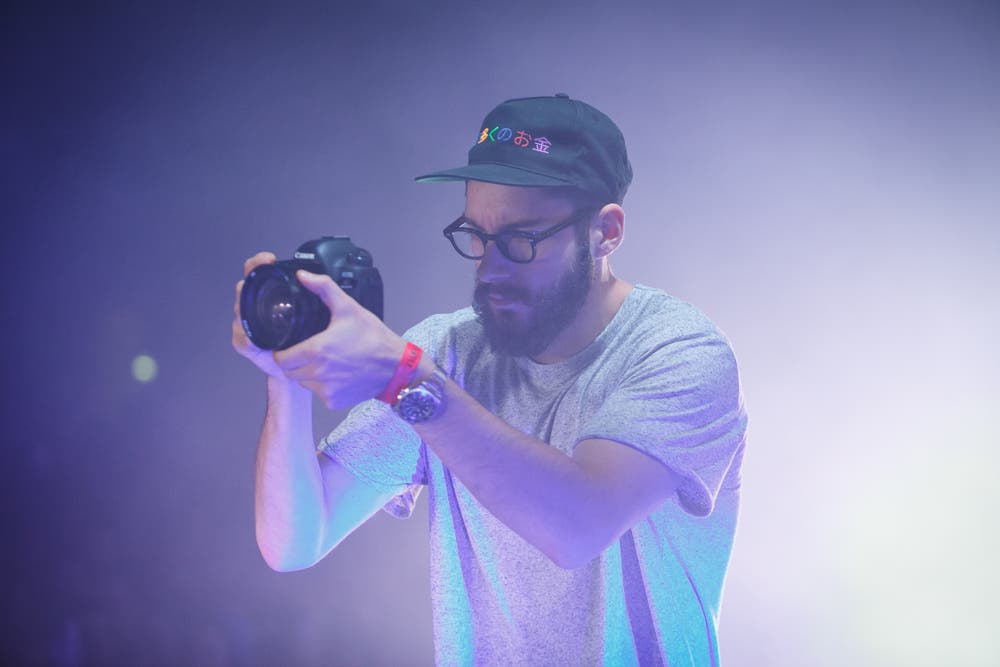So how do you start a career in concert photography? We caught up with photographers Erik Voake and Jared Polin who shared some advice on how to get started. See you in the pit!

Photo by Erik Voake.
1. Purchase a DSLR. In order to be taken seriously and obtain credentials, you need professional equipment. If you want to start a career in concert or music photography, expect to invest. “I would say the most valuable piece of equipment would be my 24-70 lens. I use it for about 90 percent of what I do,” says concert photographer Erik Voake. Zoom lenses can cost as much as the camera body, so renting is always an option. This also allows you to test-drive a lens before making a final purchase.
2. Shoot manual exposure and know your equipment. This is the step that separates the hobbyists from the experienced photographers. “Many times if you are shooting wide and you’re in a priority mode, the lights will give you a false reading and your image will end up not exposed properly,” explains concert photographer Jared Polin. Manual exposure allows you to control both the aperture and the shutter speeds. When the concert begins, you have limited time to capture your shots, so you need to be quick on your feet and familiar with your equipment.

3. Prepare for some of the best and worst lighting situations. “There are basically three different types of [concert] lighting: outdoor, indoor in a small venue, and indoor in a stadium,” says Voake. “Outdoor [metering] is tricky when performers go from light to shadow. Small indoor is tough because they often use red lighting and usually don’t have the big bright white fill lights. Stadiums are great because they always hit the performers with bright white lights, but you usually can’t get as close to them as in small venues–so that’s the trade off.” Fast lenses with image stabilization, like the Canon 70-200mm IS, help alleviate some of the issues that may occur when trying to capture a moving musician in low-light settings.

Photo by Erik Voake.

Photo by Jena Ardell.

Photo by Jared Polin.

Photo by Jena Ardell.

Photo by Erik Voake.
4. Have a reason to be there. “It’s easy is to get into shows, you just need an affiliation,” says Polin, who shoots for LiveNation. “If you don’t have an affiliation, they won’t let you in.” Only a limited number of press and photographers are allowed at each show, so make sure you are on the list. The band’s manager or publicist will be able to supply you with a photo pass. “I have been shooting for SPIN magazine for two years now,” explains Voake. “They are some of the most incredible people to work with. They give me a lot of room to grow as a photographer and obviously their name helps in getting me great access.”
5. Follow the rules: First three, no flash. Most artists only allow photographers to shoot during the first two or three songs and do not allow flash photography. The bigger the artist, the bigger the restrictions. Sometimes you will be asked to sign a release which limits the usage of the photos and grants the artist full rights to your images. Pop artists are notorious for having the most restrictions. Artists like Lady Gaga and Ke$ha only allow photographers to shoot from the soundboard, a situation which will require a really long lens and sometimes a small step ladder.
6. Don’t shoot for free. Access to a free concert is alluring, but you are providing a service and should be compensated for your time and talent. “I do understand that you may need to if your building your portfolio, but the second you have a portfolio you believe in, stop shooting for free,” recommends Voake. This step applies to any person providing a photography service. Usually online and print publications have set rates for their freelance photographers, and unless you hit it big, your paycheck will not be enough to support yourself through concert photography alone–which is even more reason to stop or never start working for free.
Inside their camera bags:
-Polin keeps a Nikon D3s and 14-24mm, 24-70mm, 70-200mm VR2 lenses
-Voake travels light with a Canon 5D, 24-70mm and 70-200mm lenses
Lens hoods, cleaning cloths, extra batteries and filters to protect your lenses in rough pit terrain (i.e.: sweat and beer) are also great investments.



-1.jpg)
